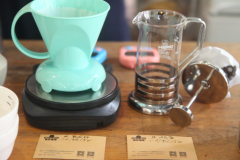Coffee bark beetle is the most serious pest in Colombia. It also has an impact on the environment.

Professional coffee knowledge exchange more coffee bean information please follow the coffee workshop (Wechat official account cafe_style)
Short-bodied nematodes can directly enter the roots of coffee, live in the roots, and invade the host tissue, resulting in the death of plants. The mortality rate of robusta infected with short-body nematode is about 40%, while that of Arabica infected with short-body nematode is 100%. The period from infancy to maturity of short body nematodes is about one month. Asyiah,I.N. The team found that endophytic bacteria can help control short-body nematodes. Endophytic bacteria located in plant cells can effectively prevent short-body nematodes from entering the root system of coffee trees. At the same time, isolates from endophytic cells can play the same role. The inhibition of endophytic bacteria on short body nematode was better than that of Alabica.
Coffee bark beetle is the most serious pest in Colombia. it also has an impact on the environment, and coffee itself has no resistance to fruit bark beetle. Gongora C.E. The team mainly carries on the research of agricultural biological control. They found that better pest control of fruit bark beetles could be achieved by using accompanying plants to grow coffee. They found seven plants that secrete ammonia, dewormed and coexisted with coffee. At the same time, they also extracted the repellent plants to make repellent, in order to make it exist in the environment for a longer time, let the fruit bark beetle in full contact with it, in order to achieve better control of the fruit bark beetle, but also can make the repellent plant into microcapsule molecules. In order to better control the fruit bark beetle, we must find the plants that can lure and expel the fruit bark beetle, mix with each other, and study the biology of the accompanying plants.
Prevention and control of diseases and insect pests in coffee trees
Four common diseases and insect pests in coffee trees-(1) leaf rust (2) anthrax (3) coffee fruit [drill fruit worm] (4) oriental fruit fly. These four kinds of diseases and insect pests are also the main diseases and insect pests in Taiwan. Other diseases and insect pests will be omitted for the time being and will be introduced later.
(1) Leaf rust (Leaf Rust) is one of fungal diseases. The pathogen likes to be wet and cool, and the serious infection is in spring and autumn. The optimum temperature for its robe germination is between 22 ℃ and 25 ℃. At the initial stage of the disease, there will be protruding light yellow powder on the back of the leaves, and the disease spot will cause the fallen leaves to kill the whole coffee tree, so leaf rust can be called the "Black death" of the coffee industry. It is less likely to happen in places where the sun is strong, and it is more likely to occur in cool, cloudy places, especially after the rainy season.)
(2) anthracnose (Coffee anthracnose Disease) is also a kind of fungal disease, but it can endure high temperature up to 30 ℃ ~ 33 ℃. It will generally infect green fruit and cause brown sunken spots, there will be light pink robes on the surface, and even infect branches and leaves, resulting in black withering of branches and falling fruit, commonly known as "fruit rot." (coffee trees need to be thinned and pruned to maintain good ventilation and adequate sunshine.)
END
Important Notice :
前街咖啡 FrontStreet Coffee has moved to new addredd:
FrontStreet Coffee Address: 315,Donghua East Road,GuangZhou
Tel:020 38364473
- Prev

[Qianjie barista's Note] are the coffee brewing parameters the same for smart cups and French presses?
Professional coffee knowledge exchange more coffee bean information Please pay attention to the coffee workshop (Wechat official account cafe_style) when talking about immersion extraction, the editor thinks of the French kettle and the smart cup, so the flavor extracted between them will be similar? Or do you have different styles? The editor will do a comparative experiment for you in a moment! Let's take a look at the Smart Cup first.
- Next

How should coffee trees be prevented when infected with coffee anthrax? Do you need to spray insecticide?
Professional coffee knowledge exchange more coffee bean information, please pay attention to coffee workshop (Weixin Official Accounts cafe_style) chemical control--- 1 75% Carboxin WP diluted 1500 times. 1 kg per hectare per application. At the beginning of the disease, it was applied once every 7 days. 2 50% Trifluroxystrobin 0.2 kg/ha per application
Related
- What is the meaning of lactic acid fermentation with coffee bean treatment?
- How to judge the state of foam by sound?
- How does the latte pull out the unicorn pattern? Come to get for a little trick to improve the flower pull!
- Will flower pulling affect the taste of the latte?
- Do you know the history of coffee?
- The difference between honey treatment and sun washing what is raisin honey treatment?
- What kind of milk can a novice use to make coffee foam to keep the foam longer? The correct method and skills of milking tutorial sharing
- Why do washed coffee beans taste sour? Flavor characteristics of washed Coffee
- Introduction to the skill of how to practice the size and height of water injection around the circle of hand-brewed coffee
- How do beginners practice coffee flower drawing from scratch?

